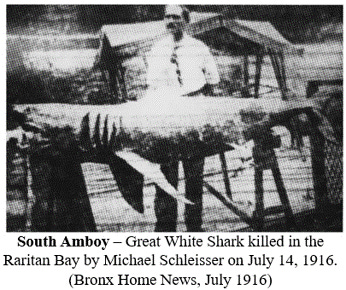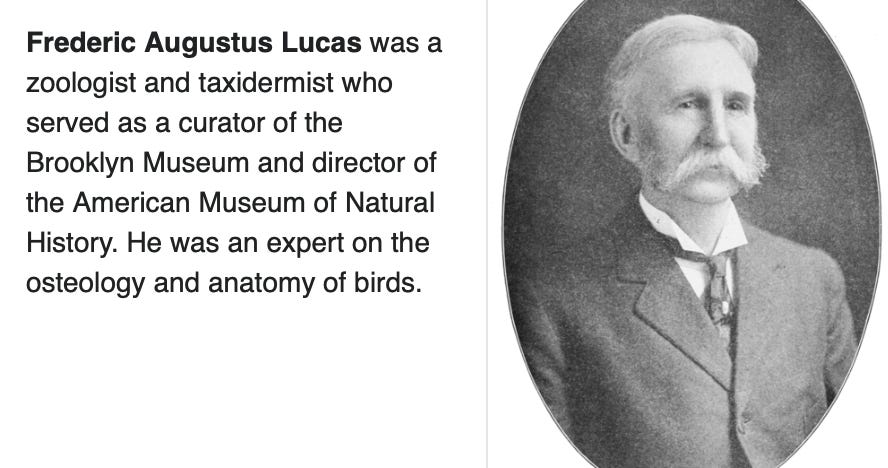In the summers of 2021 and 2022, I attended the Shark Walk presented by the Matawan Historical Society in Matawan, NJ. There I learned the true story of the 1916 shark attacks that occurred over the course of 12 days, when a series of shark attacks along the New Jersey shore left four dead and one gravely injured. This is that story.
It’s July 1916 on the Jersey Shore and there is unprecedented heat. Swimming in the ocean is kind of a new thing for most, but the water is pretty warm and a great way to cool off. But what lurks under the surface is far worse than any heat wave.
The First Attack.
July 1. It all began in the town of Beach Haven on Long Beach Island. Twenty-five-year-old Charles Vansant, walked out the door of his luxury hotel, The Engleside, to take an evening swim.
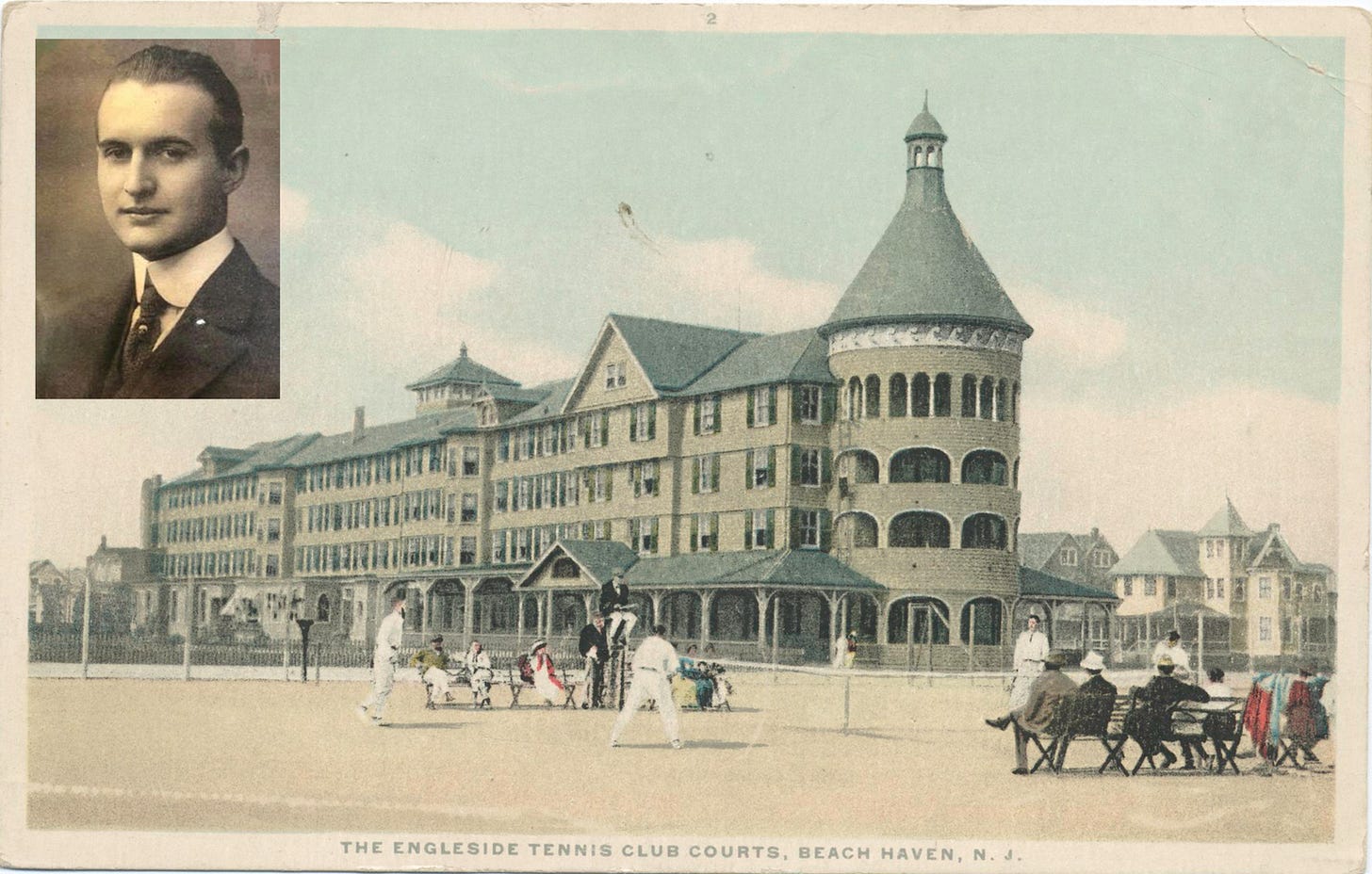
Charles either brought a dog with him or there was a dog (opinions differ), and he must have been a pretty good swimmer because he swam out through the surf and past the lines. The lifeguards reported that on his way back to shore, Charles turned and started waving, making the guards think he was waving and calling for the dog. That was not the case. He was in the process of being attacked by a shark. Finally, a man who was an Olympic swimmer saw the shark and ran out to help Charles, but by then, his femoral artery in his leg ruptured and he died on the beach.
He is buried at the Laurel Hill Cemetery in Philadelphia.
The Second Attack.
July 5. About an hour north of Beach Haven is the small, opulent beach town of Spring Lake. Victorian homes dot the oceanfront, and in 1916, the Essex and Sussex Hotel was one of the most popular hotels in the area.
Twenty-eight-year-old bell captain Charles Bruder, from Switzerland, worked that summer to support his mother back home. That afternoon during lunch, he and his co-workers headed to the beach for a swim in the employee-only swimming area. At about 2:15pm Charles and his friends were out for their usual swim in the surf. Charles was a strong swimmer and made his way out into the surf past the swim lines.
His fun ended abruptly when, shortly after heading out, Charles was attacked approximately 130 yards from shore. When two lifeguards brought a boat out to rescue him, they realized that the shark had bitten off both of his legs. Charles died on the way back to shore in the boat.
He is buried in the Atlantic View Cemetery in Manasquan, NJ.
July 8. A lifeguard out in his boat in the surf of Asbury Park encounters a large shark that he fights with his oar. He reports that the shark is twelve feet.
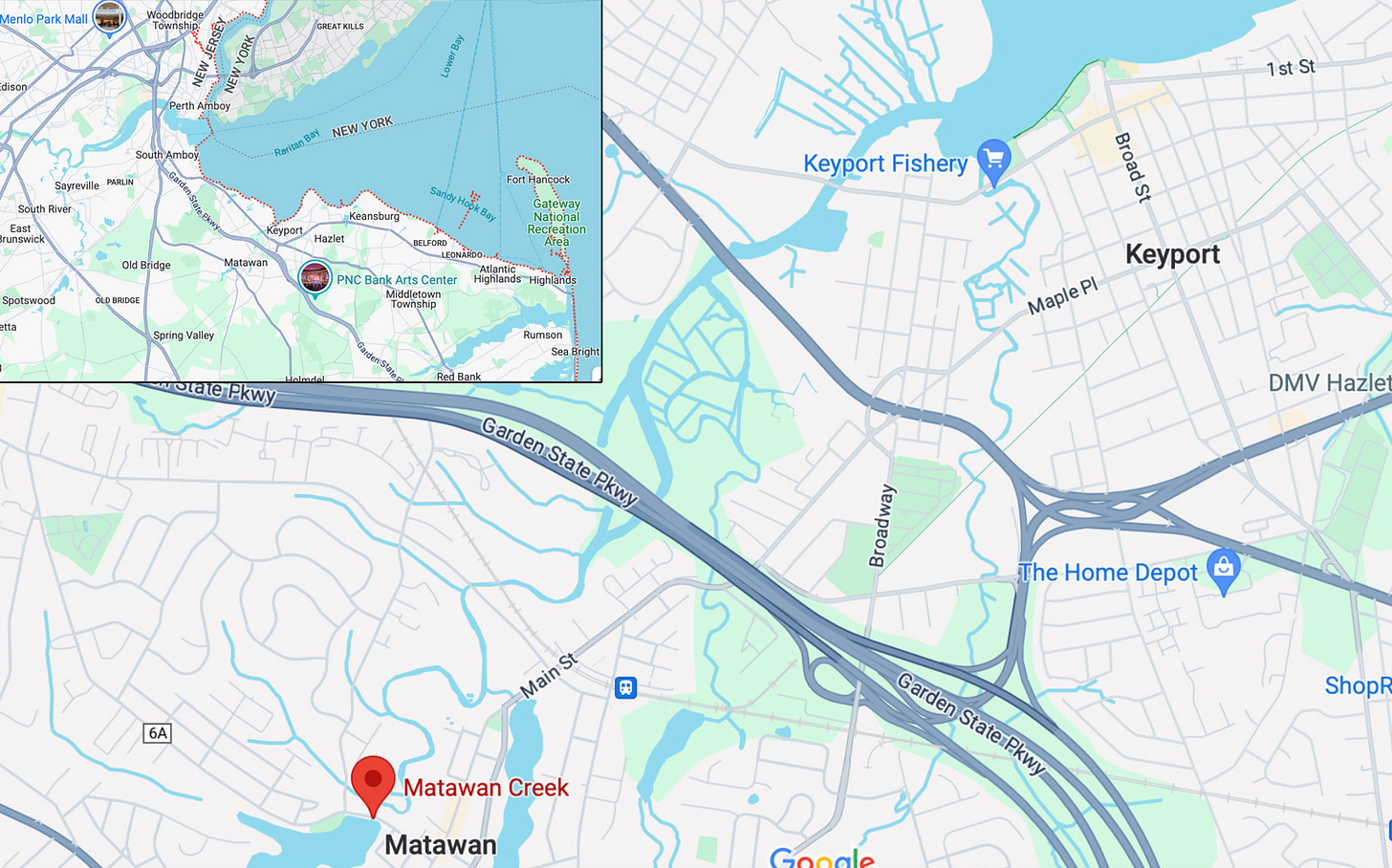
Matawan Creek Attacks.
July 12. A group of boys came running down the main street of Matawan yelling, “a shark got Lester! A shark got Lester!”. Stanley Fisher, the local tailor who was in his shop on Main Street, ran outside to ask what was the matter. One of the boys said, out of breath, “Lester Stillwell” making Stanley fisher take notice.
You see, twenty-four-year-old Stanley Fisher was already Lester’s friend, and knew that Lester had epilepsy. So, figuring that the eleven-year-old Lester was having a seizure, Stanley grabs his friend Arthur Smith and heads down the creek in a boat towards Wyckoff Dock where the boys had been swimming.
Stanley and Arthur get to Dock Street to see the whole creek filled with blood, making them realize that this isn’t a seizure, it’s a shark.
Many more residents of Matawan have now joined Stanley and they are all searching for Lester. Knowing that this was now a search and retrieve instead of a rescue, Stanley and his friend start poking the bottom of the creek with their oars trying to locate Lester’s body.
The Matawan Creek at that time is about thirteen feet deep in the center. Stanley sees Lester’s family on the creek side and realizes that he has to do something. Stanley is a very popular man in town and has spent time with Lester and his family at church.
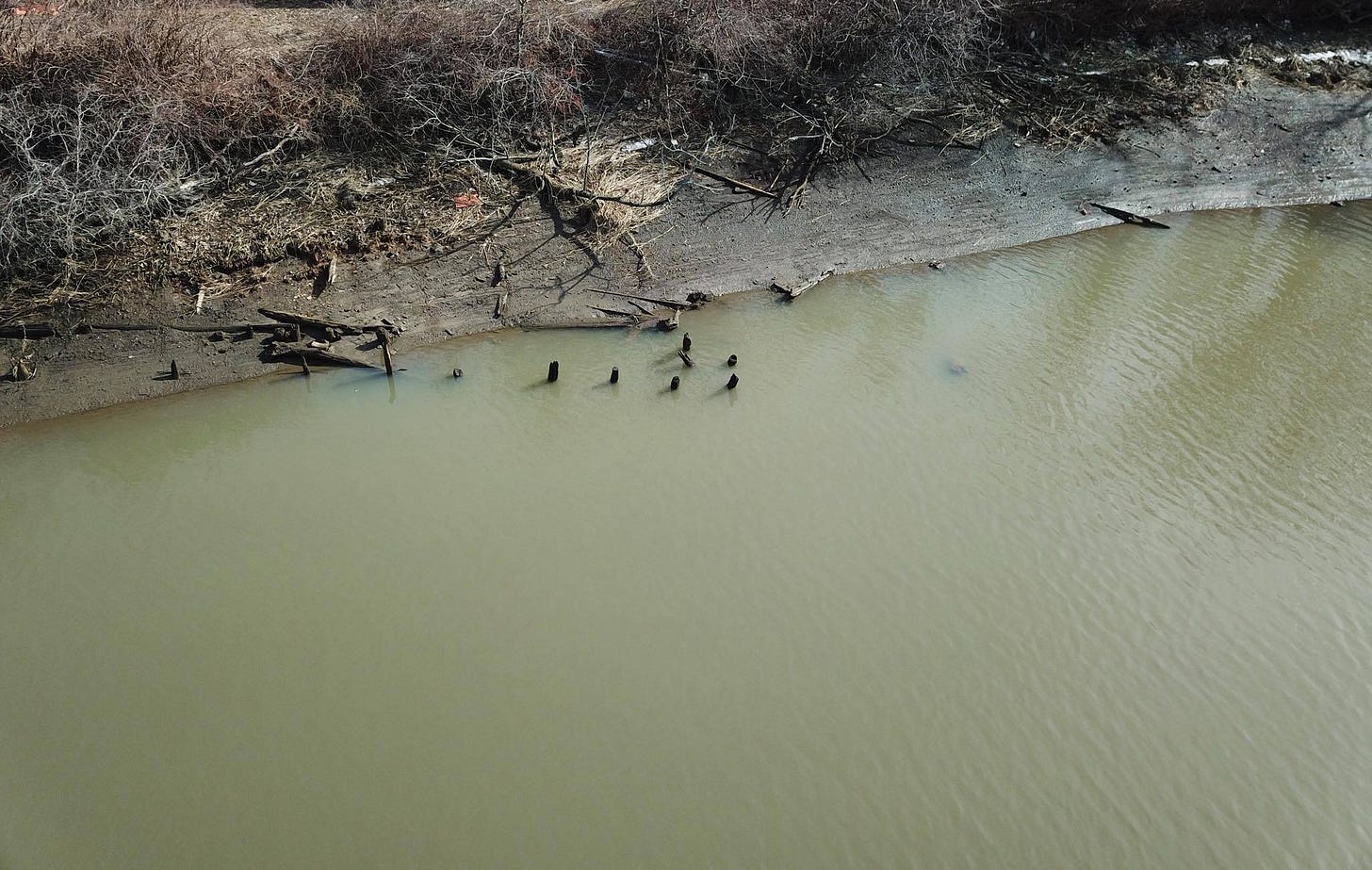
So now, while over three hundred people are watching and desperate to see his friend’s body emerge from the water, Stanley and his friend Arthur Smith jump into the water and start diving to the bottom of the creek. The people on shore are yelling to them to get out of the water, but all Stanley wants to do is find Lester.
After a little while of searching, Stanley tells Arthur that he’s going down one more time, dives and this time he finds Lester’s body at the bottom. Lester’s lungs have been punctured and are filled with water.
Stanley pulled Lester to the surface, puts his arm around him and swims for the boat. With the help of Arthur, Stanley just about has Lester out of the water when suddenly something comes from the bottom (no one sees this as the creek is so murky) and pulls both and Stanley and Lester back under the water and they both disappear.
People in boats frantically gather next to Arthur’s boat and are able to reach down and grab Stanley from the shark, but Lester’s body sinks back into the depths of the creek.
When they get him into the boat, they notice that Stanley’s femoral artery has been cut (runs from your stomach to your foot), causing him to lose a lot of blood. When they get to shore, Dr. Reynolds of Matawan examines him and realizes there are only two solutions for him: one is to take the train to Long Branch or two is to take a car to New Brunswick. They are both about the same distance. They opt for the train, which will not come for another hour. (Roads back then were very bumpy and unreliable, so the doctor thought the road could harm Stanley even more.)
At this point, every one in town is trying to save Stanley’s life.
He’s barely conscious on the train, and unfortunately, on the way to Long Branch, he loses consciousness and dies.
Before he dies, he manages to speak one sentence: “I got Lester’s body and did my duty.”
Two days later, Train conductor Harry Van Cleaf spots Lester Stillwell’s body floating in the creek by the train trestle 150 feet west of the dock where he was attacked.
Another Attack That Day.
The same afternoon, Captain Thomas Cottrell (more about him later) and lawyer Michael Leffert were trolling the creek for more shark activity and came upon fourteen-year-old Joseph Dunne swimming. While the boy tries to get into Cottrell’s boat, he is also attacked and had his lower leg and foot are shredded. He is transported to the hospital in New Brunswick, where he spends seven weeks there, then after that, disappears, never to be heard from again.
Side Note: I recently watched a video that described a search for Mr. Dunne. The creator of the video was only successful in learning that Mr. Dunne lived out on Long Island and died at the age of eighty.
The Burials.
Lester Stillwell and Stanley Fisher are both buried in the Rose Hill cemetery in Matawan, NJ. It’s interesting that Stanley’s grave overlooks Lester’s. It’s like he’s still keeping an eye on him. 😇
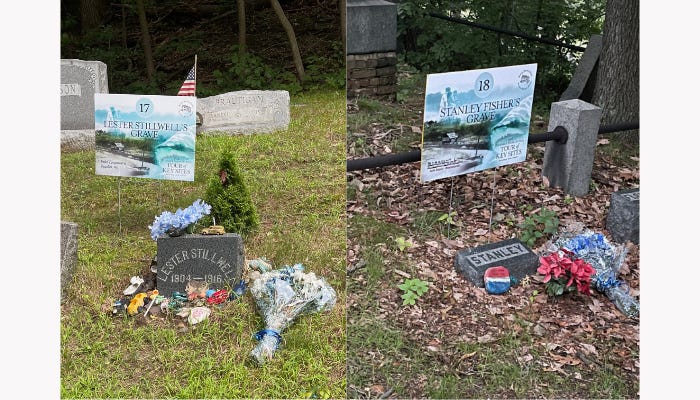
Two sharks were caught, but no conclusion as to what kind or how many.
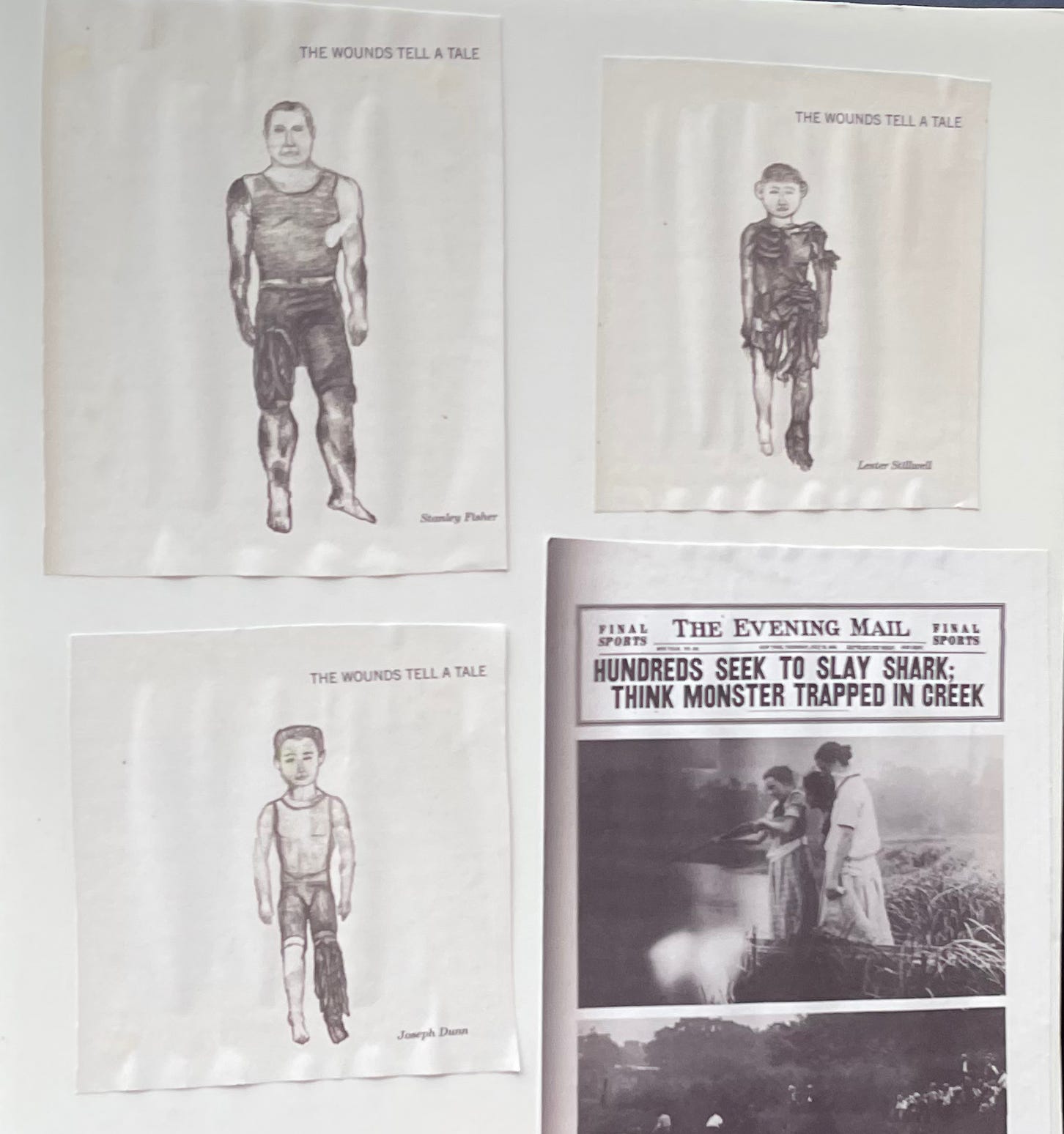
Captain Cottrell caught a twelve foot shark two days later close to the entrance to the creek. It was a great white. They cut open the shark and found human remains but… they couldn’t match the remains with that of the Lester Stillwell. The theory is that, yes, it could’ve been the lack of technology or, more likely, the following morbid fact.
Back in the early 1900s, garbage from New York City was routinely dumped into the Hudson River and was also towed out a little further into the ocean. This included medical waste from hospitals. This, they think, is why human remains were found.
Another shark was captured, and this one was caught by Michael Schleisser who was a lion tamer for Barnum and Bailey circus. He also had his shark cut open, and there were human remains, and those remains were never identified. Mr. Schleisser took the shark back to his shop in Harlem, stuffed it, and it was lost after that. (But, really, who would want that? Eww.)
Besides what I heard from the two experts during the shark walk, I’ve done my own research (Just an FYI that I had to take high school biology twice [once in college] so I’m not exactly scientific but here’s what I think.) There’s no way to say it was the same shark that attacked both Charles Bruder and Charles Van Zant. Those attacks were 45 miles apart and to say “Oh, the shark had a taste for human flesh” is impossible. Sharks do have a serious sense of smell, but it’s a lie that they can smell human blood from miles away. They may be able to smell blood, but they are more interested in searching out their usual menu of fish, mollusks, and crustaceans. It can only be assumed that the men in Spring Lake and Beach Haven were not bleeding, so it’s common sense to say it was a wrong place at the wrong time situation. Just my opinion.
Also, the experts I heard explained that three professional scientists from the Museum of Natural History in New York came to give their professional opinions.
Meet Frederic Augustus Lucas, the Director of the Museum of Natural History in New York. Dr. Lucas’ specialty is birds. Birds. Birds are not sharks. (just sayin…)
Here’s a quote from Dr. Lucas, who had little opportunity for formal education and he never sought any.
“during those days he never read through any scientific book, never attended a course of scientific lectures, never did an hour’s laboratory work, nor made a microscope slide.”
I’ll admit, I haven’t either, but I’m not the Director of the Museum of National History. According to the experts that I heard, after the attacks, Dr. Lucas, along with two other scientists from the museum, decided that it was… wait for it… an orca that attacked and killed these people. They decided that sharks couldn’t bite through bone.
I don’t think there’s been an orca on the east coast unless you count the boat from Jaws. Again, I have an art and business degree so… you make your own conclusion.
Why a great white and not a bull shark, as once reported? Again, the experts I spoke with said that a bull shark has a flat stomach and they glide along the bottom far from the top of the water and bull shark’s teeth are not adapted to chew through bone. From the witness accounts during the frantic search for Lester Stillwell, a creature that looked like a black log was seen coming out of the water. I was told that a bull shark wouldn’t come to the top, and that a great white is dark gray, so mix that with the murkiness of the creek and that’s what it would look like.
From the walk, I also learned that the area around the creek into the bay is a breeding ground for great whites. So, if you count the fact that unusual lunar activity affected the amount of salt in the creek allowing for a great white to travel further into those waters, that there are very young sharks right outside the creek who are still experimenting to find food and then there are kids and splashing around. During that year boating captains and fishermen report an abundance of sharks in the water.
People meet water. Shark meets people. Disaster. By the way, according to Floridapanhandle.com which tracts shark attack data statistics, since 1962, there have only been four shark attacks on the Jersey Shore, all non-fatal.
The conclusion? Four people lost their lives, with one injured in a twelve-day period along the Jersey Shore in July 1916. The injuries were all caused by sharks. The type of sharks and the number of them is unknown.
Book Review and Side Note.
Okay. So… years ago I decided I loved the movie Jaws so much that I should read the book. Oh, no. That was one of the worst ideas ever!!! What the heck? Wait… I’ll just say that I got to the end of the book and my husband had to duck because I was so frustrated by the awful story that I threw it across the room. (I apologized to my husband.) But hey, maybe I’m wrong because the book still brings in $6000 a month just in Amazon sales.
Side Note: Mr. Peter Benchley, the writer of Jaws, has stated that he did not base his book on the 1916 shark attacks. Apparently, no one else read this fact because there is so much on the internet that states the opposite. Who’s right? I have no idea — I would have to ask the author, who succumbed to pulmonary fibrosis in 2006. But he lived in New Jersey, so… who knows?
Aftermath.
In 1916, the attacks put the Jersey Shore literally on the map! All the hotels filled up with sightseers trying to get a look at the killer sharks.
I don’t know if the Jersey Shore ever recovered from the 1916 shark attacks. I say that not because there the lack of beach attendance — the Jersey Shore beaches are beautiful and even more popular than ever — but because over one hundred years later people can’t stop being curious about this story. Every year the shark walk almost doubles in size because of this curiosity. But if you visit the Jersey Shore beach and go for a swim, don’t worry too much about sharks, but… I hope you never hear this:
"Boys, oh boys! I think he’s come back for his noon feeding." - Dr. Matt Hooper, Jaws Movie.

One last side note: This story is really about bravery. The bravery of the lifeguards, of the man who tried to rescue Charles Bruder, and the bravery of the Stanley Fisher and the many, many people who tried to save people that day. At the end of Dock Street, there sits a plaque dedicated to the survivors and the brave people that day who tried to help their neighbors. I think the bible verse of John 15:13 sums it up: Greater love has no one than this, that someone lay down his life for his friends.
Want to go on your own shark walk or learn more? Visit the Matawan Historical Society, which is a GREAT organization that preserves the history of the area - and they do it in the most interesting ways! They have a shark walk, a Halloween walk — all sorts of stuff. I suggest visiting them! It’s worth it. 🙂 https://matawanhistoricalsociety.org







